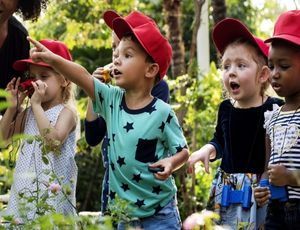Pregnancy is often seen as a time of preparation for the big day when your little one will be born, but what if we explore the idea that your child has already been living for nine months? Now we can look at birth as a process of life instead of the beginning of it. In this month’s article, we will look into the importance of the prenatal life and the experiences the unborn child undergoes during this period. We will also mention practical steps to connect with your baby and deepen your personal experience of parenting.
Pregnancy is a time for parents to center their attention on preparing themselves for the day their baby will arrive. This usually entails arranging the nursery for the new baby that will come. They carefully choose and buy the many items and gadgets needed to take care of the baby and satisfy all of his basic needs. Prenatal appointments with the doctor or midwife are scheduled, and a due date is estimated for the baby to be born. All of this is important for the baby’s arrival, but it is also essential to look into the experiences the baby is now having inside the womb. There are many ways in which the emotional life and daily rhythms of the parents influence the unborn baby.
The child and mother influence each other, both biologically and emotionally. The baby is not a passive passenger; in fact, he is in command of the pregnancy. The baby is affected by its mother’s daily habits, emotions, and temperament; when the mother receives stimuli from the environment, she reacts, and the baby receives this information through her body. It is a form of learning which changes the baby. The baby responds differently when the mom is calm or stressed, happy or angry, or rushed or relaxed. Therefore, it makes sense that during pregnancy, parents should try to connect with the baby. There are many ways this can be done.
Around eight weeks of gestation, the skin of the baby is thoroughly developed. The sense of touch is an important source of information about himself and the environment. This sense allows us to communicate even if the other senses are not developed yet or are lost. When we are touched, there is always reciprocity and the possibility of a relationship. Parents can touch the mother’s belly gently with their hands, and around the fourth month of pregnancy, they can see the baby’s reaction to that movement.
At five months of gestation, the auditory nerves can carry messages from the ear to the brain. The baby hears many sounds since the amniotic fluid amplifies sounds both inside and outside the womb. Inside, he can listen to his heartbeat and the heartbeat of his mother. The pulsation of the blood going from the arteries to the placenta, the last meal the mom ate traveling through the intestines, and the bowel movements can all be heard. But what about the sounds outside the womb? Dogs barking, cars honking, and ambulance sirens are all heard by the baby; these are unintentional stimuli in the environment. We can intentionally stimulate the baby by talking to him, and he will absorb the particular rhythms of the parent’s language. In a way, he will already be learning the language. Another way to connect with the baby is to sing to him; parents can have special songs for the baby that can be of great help after birth to calm the baby since he will recognize them. There is a benefit for the mom when she sings to the baby because it strengthens the diaphragm and all the muscles of the thorax and pelvis, which are the muscles she will use during childbirth.
Meditation and breathing are also great ways to connect with your body and baby. They can be done just by the mother or as a couple. Check around your area for groups of parents-to-be that meet weekly to meditate, or look for prenatal yoga, which incorporates plenty of breathing techniques for pregnancy and labor.
Book of the Month
The World of the Unborn: Nurturing your Child Before Birth by Leni Schwarts, Ph.D
This is an excellent book for couples planning on having a child or currently pregnant. It provides insight into the process of becoming parents and higher levels of understanding of what happens during pregnancy and why all experiences have an enormous impact on the unconsciousness of the child in the womb.
From Thrift Books: https://www.thriftbooks.com/w/world-of-the-unborn_leni-schwartz/1135666
Item of the Month- The Topponcino
The Topponcino was first used in the 1940s by Dr. Maria Montessori. It is a soft, handmade pillow that provides support and consistency to your baby throughout the first few months of life. It supports your baby when feeding or when being held by people that are not used to holding babies. The neck, head, and body are consistently supported, and your baby won’t feel insecure when being carried. All materials are natural and gentle on your newborn’s skin. It is recommended that you sleep with the Topponcino for a few weeks before the baby is born so it absorbs your smell, and later on, when your baby uses it, he will recognize the scent and feel comforted by it.
Link to buy it at The Topponcino Company: https://topponcinocompany.com/?gclid=EAIaIQobChMIjLr12_e46gIVRJFbCh2JCgXvEAAYASAAEgKG1_D_BwE
Quick Montessori Tips for Your Baby’s Nursery
- Add a mirror so your newborn can observe his reflection. It should be at the same height as your newborn. This will help him build a stereognosis sense of his body.
- Place décor at your child’s height; many nurseries are beautifully decorated at an adult’s height so the child is not able to appreciate it. Try hanging the pictures or any décor you have very low, so your baby can see it. The nursery is meant for him, not for the adults.
- Have black and white cardboard books available for your child. In the first couple of weeks, your newborn will be able to appreciate shades of gray, black, and white only. He will be attracted to shadows and lights too. The books and cards of Wee Gallery Art are recommended, and they are available at Amazon at https://www.amazon.com/s?k=wee+gallery&ref=nb_sb_noss_1.
- Bring nature into the nursery. Many indoor plants will work well in your newborn’s space, and an added bonus is that many plants have air-purifying qualities. Having nature available for your child from a young age fosters a sense of responsibility, appreciation, and connection to the world. Make sure to check the description of the plant before you buy it to ensure it is non-toxic.



